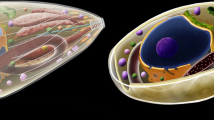Summary
Sporozoites of Eimeria contorta inoculated into monolayer cultures of bovine embryonic kidney cells and Madin-Darby bovine kidney cells developed to mature second-generation schizonts, which were first seen 72 hr after inoculation. In cultures of bovine embryonic intestine cells, only mature first-generation schizonts developed. Intracellular sporozoites became U-shaped before transforming into trophozoites with a prominent refractile body. Sporozoite-shaped schizonts were not seen. At 30 hr after inoculation, merozoites began to form as conical protrusions of the surface of schizonts with 25–35 nuclei. Mature first-generation schizonts (25 by 20μ), with 25–35 merozoites each having two refractile bodies, were first observed at 46 hr. The merozoites averaged 9.5 by 2.0 μ. After enough sodium taurocholate to make a concentration of 0.01% was added to the cultures, merozoites left their host cells, entered others and transformed into trophozoites within 4 hr. Merozoite formation frequently began with the appearance of conical protrusions at opposite poles of second-generation schizonts. During the late stages of their development, the 8–15 merozoites were spirally arranged around the central residual body. Mature schizonts and merozoites averaged 19 by 8.5 μ and 22.5 by 1.4 μ, respectively. In some cultures, larger schizonts with 30–40 merozoites, arranged rectilinearly with respect to the residual body, were observed. On the basis of a comparison with the corresponding stages of E. nieschulzi, it is concluded that E. contorta is a valid species.
Similar content being viewed by others
References
Colley, F. C.: Fine structure of schizonts and merozoites of Eimeria nieschulzi. J. Protozool. 15, 374–382 (1968).
Danforth, H. D., Hammond, D. M.: Stages of merogony in multinucleate merozoites of Eimeria magna Pérard, 1925. J. Protozool. 19, 454–457 (1972).
Fayer, R.: Refractile body changes in sporozoites of poultry coccidia in cell culture. Proc. helminth. Soc. Wash. 36, 224–231 (1969).
Fayer, R., Hammond, D. M.: Development of first-generation schizonts of Eimeria bovis in cultured bovine cells. J. Protozool. 14, 764–772 (1967).
Haberkorn, A.: Die Entwicklung von Eimeria falciformis (Eimer 1870) in der weißen Maus (Mus musculus). Z. Parasitenk. 34, 49–67 (1970a).
Haberkorn, A.: Zur Empfänglichkeit nicht spezifischer Wirte für Schizogonie-Stadien verschiedener Eimeria-Arten. Z. Parasitenk. 35, 156–161 (1970b).
Haberkorn, A.: Zur Wirtsspezifität von Eimeria contorta n. sp. (Sporozoa: Eimeriidae). Z. Parasitenk. 37, 303–314 (1971).
Heller, G.: Elektronenmikroskopische Untersuchungen zur Schizogonie in den sog. kleinen Schizonten von Eimeria stiedae (Sporozoa, Coccidia). Protistologica 7, 461–469 (1971).
Kelley, G. L., Hammond, D. M.: Development of Eimeria ninakohlyakimovae from sheep in cell cultures. J. Protozool. 17, 340–349 (1970).
Lepp, D. L., Todd, K. S., Jr.: Life cycle of Isospora canis Nemeseri, 1959 in the dog. J. Protozool. 20, in press (1973).
Long, P. L.: In vitro culture of Eimeria tenella. IInd Internat. Congr. Parasit. J. Parasit. 56 (Suppl.), 214–215 (1970).
Marquardt, W. C.: The living, endogenous stages of the rat coccidium,Eimeria nieschulzi. J. Protozool. 13, 509–514 (1966a).
Marquardt, W. C.: Attempted transmission of the rat coccidium Eimeria nieschulzi to mice. J. Parasit. 52, 691–694 (1966b).
Mayberry, L. F., Marquardt, W. C.: Transmission of Eimeria separata of the rat to the laboratory mouse, Mus musculus. Program and Abstracts 47th Ann. Meet. Amer. Soc. Parasitol., Miami Beach, p. 62 (1972).
Müller, B. E. G., DeVos, A. J., Hammond D. M.: In vitro development of first-generation schizonts of Eimeria canadensis Bruce, 1921. J. Protozool. in press (1973).
Musajev, M. A., Ismailov, S. G.: Endogenous stages of the life cycle of Eimeria schamchorica Musajev et Alijeva, 1961 (Sporozoa, Coccidia) the parasite of Meriones erythrourus Gray. Acta protozool. 9, 223–235 (1971).
Parker, R. C.: Methods of tissue culture, 3rd ed., p. 145–151. New York, N. Y.: B. Hoeber, 1961.
Roudabush, R. L.: The endogenous phases of the life cycles of Eimeria nieschulzi, Eimeria separata and Eimeria miyairii coccidian parasites of the rat. Iowa State Coll. J. Sci. 11, 135–163 (1937).
Shah, H. L.: The life cycle of Isospora felis Wenyon, 1923, a coccidium of the cat. J. Protozool. 18, 3–17 (1971).
Speer, C. A., Hammond, D. M.: Development of Eimeria larimerensis from the Uinta ground squirrel in cell cultures. Z. Parasitenk. 35, 105–118 (1970).
Speer, C. A., Hammond, D. M.: Development of first- and second-generation schizonts of Eimeria magna from rabbits in cell cultures. Z. Parasitenk. 37, 336–353 (1971).
Speer, C. A., Hammond, D. M., Anderson, L. C.: Development of Eimeria callospermophili and E. bilamellata from the Uinta ground squirrel Spermophilus armatus in cultured cells. J. Protozool. 17, 274–284 (1970).
Speer, C. A., Hammond, D. M., Elsner, Y. Y.: Development of second-generation schizonts and immature gamonts of Eimeria larimerensis in cultured cells. Proc. helminth. Soc. Wash. 40, 147–152 (1973).
Speer, C. A., Hammond, D. M., Kelley, G. L.: Stimulation of motility in merozoites of five Eimeria species by bile salts. J. Parasit. 56, 927–929 (1970).
Todd, K. S., Jr., Hammond, D. M.: Life cycle and host specificity of Eimeria callospermophili Henry, 1932 from the Uinta ground squirrel Spermophilus armatus. J. Protozool. 15, 1–8 (1968a).
Todd, K. S., Jr., Hammond, D. M.: Life cycle and host specificity of Eimeria larimerensis Vetterling, 1964, from the Uinta ground squirrel Spermophilus armatus. J. Protozool. 15, 268–275 (1968b).
Todd, K. S., Jr., Lepp, D. L.: The life cycle of Eimeria vermiformis Ernst, Chobotar and Hammond, 1971 in the mouse Mus musculus. J. Protozool. 18, 332–337 (1971).
Author information
Authors and Affiliations
Additional information
This investigation was supported by PHS Research Grant No. AI-07488 from the National Institute of Allergy and Infectious Diseases and by a fellowship awarded to B. E. G. Müller by the German National Fellowship Foundation. Published as Journal Paper No. 1339, Utah Agricultural Experiment Station.
Rights and permissions
About this article
Cite this article
Müller, B.E.G., Hammond, D.M. & Scholtyseck, E. In vitro development of first- and second-generation schizonts of Eimeria contorta haberkorn, 1971 (coccidia, sporozoa). Z. Parasitenk. 41, 173–185 (1973). https://doi.org/10.1007/BF00329485
Received:
Issue Date:
DOI: https://doi.org/10.1007/BF00329485




